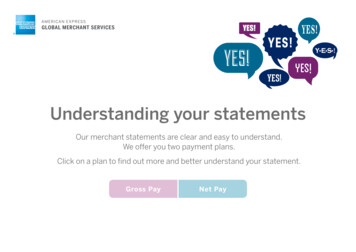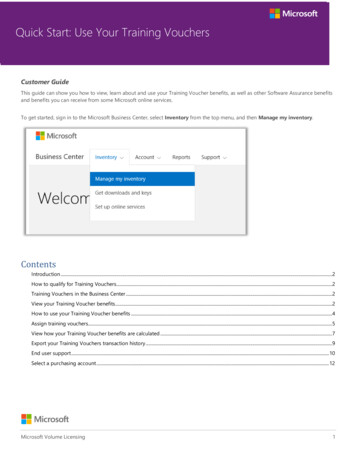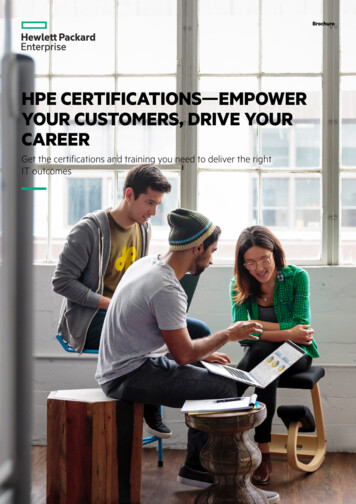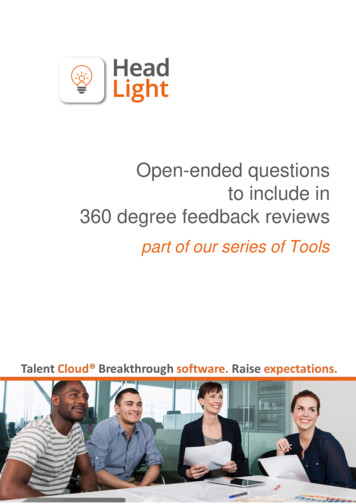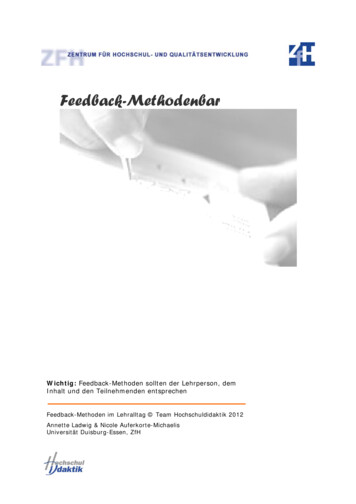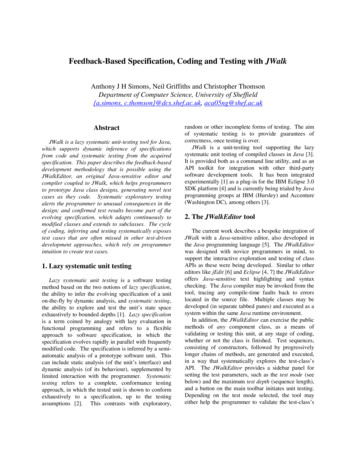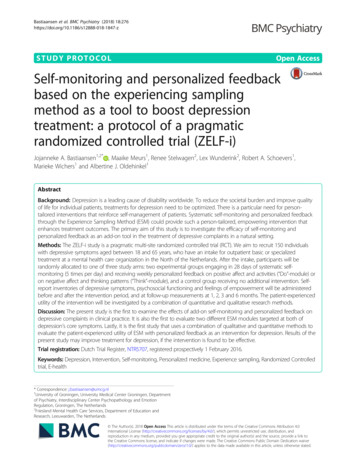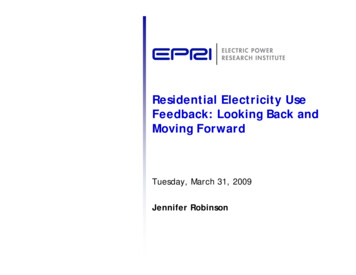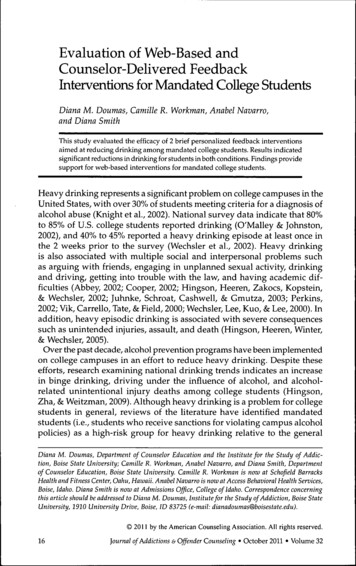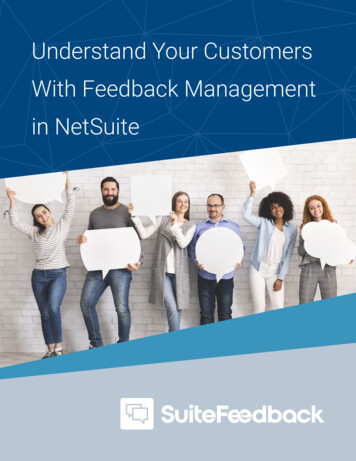
Transcription
Understand Your CustomersWith Feedback Managementin NetSuite
Table of ContentsCustomer Experience Is Your Only Differentiator3Relationship/Brand NPS vs. Transactional/Experience NPS 4Putting NPS Feedback Into Action 5Put Customers at the Center of Your Business With SuiteFeedback and NetSuite6More Effective ROI Measurement 7The Real Value of SuiteFeedback 8NetSuite and SuiteFeedback: The Perfect Pair 9
Customer Experience Is Your Only DifferentiatorTechnological advancements have allowed people to launch any product or service they can dream up withsurprisingly little cash. You can rule out speed to market, cost efficiency, uniqueness, and price as the ultimatedifferentiators. Now, there’s a new battleground. Successful companies differentiate themselves by providing anexcellent customer experience.The customer experience is often thought of as a vague component of brand identity, but it’s much more thanthat. Today, companies can gather valuable feedback from customers and act on it, which allows them to unlockbottom-line growth by understanding and retaining customers.Businesses use various surveys and software to measure the customer experience, but even though they get thefeedback, they don’t understand it or know what to do with it. It often sits in an Excel sheet or a Net PromoterSystem software, uncoupled from or barely integrated into a system of record. Another data silo with access to afew users.In this whitepaper, we’ll show you how to get feedback, understand it, manage it, and get value out if it withSuiteFeedback in NetSuite, your system of record.The System ThatRules Them All:Net Promoter SystemMethodologyThe Net Promoter System assesses customer loyaltythrough ongoing customer feedback collected fromshort but effective surveys. You can calculate abaseline score by asking just a single question:The Net Promoter System is a proven methodologythat’s used for measuring customer loyalty andfuture growth through firsthand feedback. It links thecustomer experience and resulting customer behaviorto the business metrics that truly matter: loyalty andgrowth. Net Promoter Score (NPS) is a popularcustomer experience metric because it is simple,effective, and directly correlated with future growth.In fact, the NPS is the primary indicator of growthpotential. The NPS is used to measure, segment,understand, and track the customer experience.“On a scale of 0-10, how likely is it that you wouldrecommend [company name] to your friends, family, orcolleagues?”Customers that respond with a 6 or below areconsidered detractors of that company. Thosethat answer with a 7 or 8 are considered passives.Customers that give a 9 or 10 are promoters of abusiness or brand. To determine your NPS, subtractthe percentage of promoters from the percentage ofdetractors. For example, if 50% of respondents wereclassified as promoters and 10% were detractors, yourNPS is 40.Success can be measured by looking at annualretention rate, churn rate, and referral sales rate. Eachof these can tell a company quite a bit about thecustomer experience it’s delivering, and together, theyprovide a good gauge of overall business health andfuture growth.It’s that simple, but it has huge value if you know howto manage it.Customers that give a 9 or 10 are promoters of a business or brand.3
Relationship/Brand NPS vs. Transactional/Experience NPScustomer journey. For instance, it could be sent out 30days before renewal, after onboarding, after receipt of thefirst invoice, 15 days after placing the first order, etc. Thisprovides more actionable feedback than rNPS.As its name suggests, Relationship NPS (rNPS), also knownas Brand NPS, can be calculated by asking customersquestions about their overall relationship to a business.These would be much like the question above: “How likelyare you to recommend [company name] to a friend orcolleague on a scale of 0 to 10?” This allows surveyorsto gauge a customer’s feelings based on all of their pastexperiences with and overall impressions of the business.These questions are asked of all customers (or a selectsubset — not just the most recent ones) at regular intervals,such as quarterly or annually.Where rNPS shines is as a competitive benchmark. It allowsyou to effectively compare your business’s performancewith the performance of others in your industry, giving youa tangible way to see how you stack up to the competition.It also allows you to measure the satisfaction of customersafter they’ve been able to use your product or experienceyour service over a longer period of time.Transactional/Experience NPS (tNPS), in contrast, assessesa customer’s feelings immediately following a transaction or“moment of truth” with a company. An example of a questionthat measures tNPS might be “Based on your recentpurchase, how likely are you to recommend [company name]to a friend or colleague?”If your scores are high and continually increasing, it’s asignal that your business will grow with new and currentcustomers. If they’re dropping, it might mean you’reacquiring customers but not retaining them, meaning thatyou’re overextended and should refocus on optimizing youroffering for your current customers.tNPS can serve as a useful diagnostic for identifyingelements of your product or service that need to beimproved. It can be tied to specific data points or “momentsof truth” that correspond with certain phases of theSuiteFeedback segments rNPS and tNPS surveys, as it is keyto understand these individually.Advantages of NPS Predicts future business growth Indicates overall business health Identifies improvement areas Provides the best customer relationshipkey performance indicator Has the highest response rates of all customerexperience metrics Provides a competitive benchmark Is simple and easy to understand4
Putting NPS Feedback Into ActionNPS, or any other customer feedback, is useful onlyif you take action on the feedback you receive fromcustomers. And don’t just look at the score itself — thecomments provide much more insight.Analyzing the feedback and taking action showscustomers that you’re listening and truly care abouttheir feedback, which will improve overall engagementwith your brand. By turning feedback into action,you’re able to turn detractors into promoters, and youcan learn from promoters what makes your businessdifferent so you can double down in those areas.Different Actions for Promoters and DetractorsFeedback received from promoters will mandatedifferent responses than feedback from detractorsor passives. Additionally, a response might requiremore than one action. Basic feedback managementsoftware or NPS tools will typically call for a limitedrange of actions.By acting immediately after identifying detractors inyour top customer segments, you can turn them intopromoters and boost renewals and referrals.Ultimately, you’ll want to measure the impact of allactions, which will not only improve your business, butalso allow you to ask more effective questions in thefuture. These actions can be measured in NetSuite.For instance, feedback from a detractor might promptyou to open a case in NetSuite or a Zendesk ticket,email a sales manager or account executive, or send amessage to a particular Slack channel.The process of taking action on feedback is known asclosing the feedback loop.Promoter responses might signal a customer referralrequest or the need to offer a special discount, productpreview, reference, or some other loyalty bonus.Whether your customers are retail consumers orenterprise businesses, those who love what you do willusually be happy to talk about you, but some will needan extra incentive.Traditional survey or NPS softwaremakes it easy to capture feedback,but because these tools are notfully built into your system ofrecord, it’s difficult to takeaction and understand thefeedback because responses aresitting in another system.Remember, promoters buy more, frequentlyrepurchase, consolidate their business with you, andare more tolerant of price increases. And they costless, too. But detractors have a high churn rate and willpublicly disparage your brand.Why Closing the Loop Matters It shows customers that you care. It allows you to pinpoint the root causes ofsatisfaction and dissatisfaction. You can capitalize on promoter reviews and referrals. It improves loyalty, upsells, and retention. You can prepare the next loop. It has a huge impact on improving thecustomer experience.5
Put Customers at the Center of Your BusinessWith SuiteFeedback and NetSuiteSuiteFeedback is a modern feedback managementsystem natively built on the NetSuite unified cloudsuite, your system of record. It allows you to collectfeedback, route it to the right team members, andreach out to customers with customized follow-upworkflows. In short, it allows you to turn insights intoimmediate, transformative action.Once feedback is collected in NetSuite usingSuiteFeedback survey templates, you gain a360-degree view of customers. Rather than storingcustomer responses in an Excel spreadsheet or siloedNPS software — where it could soon be forgotten —SuiteFeedback turns responses into actions defined byyou to improve the customer experience.For customer-facing teams, executives, and managers,measuring NPS with SuiteFeedback also means lessguesswork. Everyone with access to NetSuite can geta clear picture of customer health by seeing the NPSon a customer record and on NetSuite dashboards forany role.Moreover, reporting on overall customer health andsatisfaction is as simple as running a report andbuilding a NetSuite dashboard. Plus, teams can viewNPS in the greater context of NetSuite data, meaningsurvey responses can be sliced and diced to revealimportant nuances and meaningful trends tailored toyour needs.Put Your NPS System on Autopilot in NetSuite Survey each customer at the right time. Automate feedback data collection with surveys thatcorrespond to the unique journey of your customers. Execute rNPS quarterly, biannually, or annually, ortNPS after a transaction. Choose the number of reminders customers receiveand how frequently they’ll get them. Prevent survey fatigue with global or pre-surveyrules that stop too many requests from goingto customers. Understand customer value by correlating NPSsegments with lifetime value. Collect customer feedback in a frictionless, fast way. Create custom reports using all NetSuite recordsand fields. Respond to feedback individually or at scale. Automate follow-up with workflows and actions. Engage your whole team to create acustomer-obsessed culture. Receive automated survey reminders.6 Schedule periodic rNPS surveys.
More Effective ROI MeasurementTrue ROI measurement is really possible whenfeedback management is built into the system ofrecord, where you can understand feedback togetherwith top customers, top products, segments, etc.With SuiteFeedback, your customer feedback datais on NetSuite records, so you can use it to createyour own searches, reports, and workbooks on top ofdashboards, KPI scorecards, and roles. More than 45reports and dashboards are included out of the box foryou to start understanding the value of feedback.business, so it’s easy to understand and analyze. Youcan execute automated workflows on any NetSuiterecord and easily segment responses based on realbusiness metrics. SuiteFeedback also makes it easy tounderstand the value of customer segments attachedto response data.Would you like to get an immediate notification whenone of your top 10 customers in terms of lifetimevalue gives you a bad rating? Who wouldn’t? This isthe real value of SuiteFeedback. Operational, financial,and experience information in one place.All response data is associated with customer,contact, transaction, item, project, and case records,as well as any custom records related to yourKeep It in the Suite“Suiteness” is about having a single unified system across all functions of a company, including finance, supply chain,inventory, service and support, e-commerce, engineering, sourcing and procurement, merchandise, human resources,and any other function that’s critical to your operation — customer feedback included. It feels like magic when asingle system is able to support software, wholesale, retail, and service business models, but the real magic comeswhen you add the customer feedback layer.You don’t want a siloed system for collecting NPS and customer feedback. SuiteFeedback allows you to keep it all inNetSuite, where you can act and understand the feedback to drive impactful customer loyalty and growth.7
The Real Value of SuiteFeedbackIntegrating your NPS efforts into NetSuite with the built-in feedback management ofSuiteFeedback will ensure your entire team is always taking the steps necessary to close theloop on customer feedback. Here’s what makes SuiteFeedback different from other survey andfeedback management software:1. IntegrationAnyone who has experience with NPS software vendors will give prospective customersthe same advice: “Make sure it plays well with your CRM.” Not to worry — SuiteFeedbackis built into your CRM and ERP system. No new system integrations. This is Suiteness!2. Employee and executive engagementRole-based dashboards, reports, and data are all in the Suite, so they can be easilyincorporated into daily data checks, insight reviews by any role, and daily workflows. Highadoption, limited to no formal training, and shareability. No need to use another systemto see value right away. We don’t charge a “user” tax!3. Data segmentationWith SuiteFeedback, there’s no need to move fields and values between systems. Youcan segment groups and responses by product, subscription, sales rep, support person,class, department, subsidiary, date of first invoice, lifetime value, order frequency, andmore. You can also easily view correlations between transactional, customer, item, andfeedback data and find meaningful insights in the relationship between specific datapoints. Build saved searches, workbooks, and reports to understand feedback data in theSuite. It’s all in NetSuite!4. Real-time ROI measurementSuiteFeedback allows you to see exactly how your customer experience program isadding value to your business and impacting profit and growth. When feedback data istied to your system of record, you’re able to understand when and how to take action inorder to improve loyalty, reduce churn, and generate referrals.As we said earlier, SuiteFeedback allows you to get an immediate notification when a top10 customer in terms of lifetime value gives you a bad rating. Who wouldn’t be excitedabout that? This example illustrates the value of SuiteFeedback.8
NetSuite and SuiteFeedback: The Perfect PairWhy use another system to measure and manageyour NPS when you can execute and manageNPS surveys and store and take action oncustomer feedback directly in all the records thatmatter to your business? Because SuiteFeedbackis built in NetSuite, it’s more flexible and leveragesthe SuiteCloud platform to deliver customizationand integration capabilities that other softwarecan’t provide. This ensures it’s always up-to-dateand provides you with sophisticated role-basedsecurity so executives, managers, and otherleaders are equipped to support themselves andtheir teams.Like SuiteCommerce, SuitePeople, WMS, andother NetSuite add-ons, SuiteFeedback ensuresimportant information is available throughoutyour entire business so the right people can getinsights and take action to close the feedbackloop with customers.Unified access means feedback informationcan be seamlessly reported and analyzed, fromexecutives and managers to support to the shopfloor and the warehouse. And no matter where inthe world you do business, SuiteFeedback givesyou a global reach. Built on a global platform, ourapp can work with your subsidiaries all over theworld and be translated into any language.Although most customer experience softwarevendors charge by the user, SuiteFeedback isavailable to all users with access to NetSuite.Our goal is to ensure your business success —we don’t make it prohibitively expensive for youremployees to access and act on the data that willmove your company forward.Your NPS and the associated feedback shouldn’tbe vanity metrics. With SuiteFeedback, you’ll learnhow feedback directly impacts your bottom line —and be able to turn it into a competitive edge.Want to learn more? Contact us today to request a demoof SuiteFeedback and start putting your customers atthe center of your business in NetSuite.
For customer-facing teams, executives, and managers, measuring NPS with SuiteFeedback also means less guesswork. Everyone with access to NetSuite can get a clear picture of customer health by seeing the NPS on a customer record and on NetSuite dashboards for any role. Moreover,
